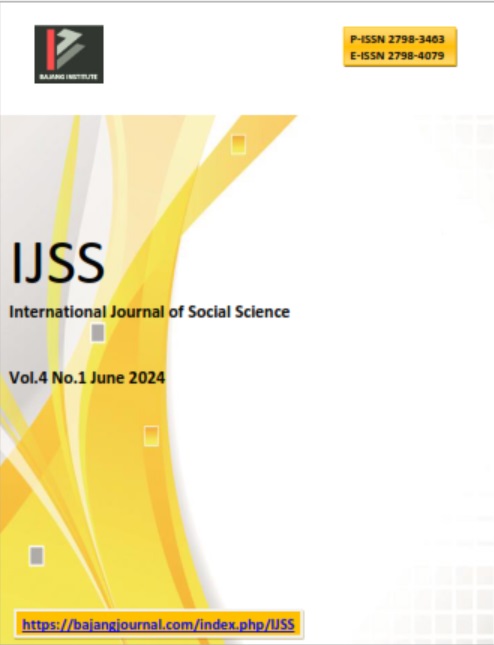THE ROLE OF CITIZENSHIP EDUCATION IN PREVENTING ETHNIC CHINESE BULLYING POST COVID-19 PANDEMIC IN ISLAMIC SCHOOLS
DOI:
https://doi.org/10.53625/ijss.v4i1.7918Keywords:
Citizenship Education, Bullying, Chinese EthnicityAbstract
The aim of this research is to find out and analyze further regarding 1) How bullying behavior towards ethnic Chinese occurs after the Covid-19 pandemic in Islamic schools, 2) What is the role of Framing Media regarding the Covid 19 pandemic which encourages bullying behavior towards ethnic Chinese in Islamic schools , 3) How does citizenship education prevent bullying of ethnic Chinese after the Covid-19 pandemic in Islamic schools. This research uses qualitative methods to obtain theories and argumentative bases based on the results of literature research from various sources such as magazines, articles and books and related to the problems to be solved. As we know, currently many teenage attitudes are emerging that are contrary to multiculturalism. Among them, bullying behavior often occurs, especially among school children. Bullying is said to be a form of child abuse carried out by peers of the same age against someone (child) who is "lower" or weaker in order to gain their own advantage or satisfaction. Bullying behavior that often occurs in school children is verbal, for example mocking the ethnicity of other students. Therefore, Citizenship Education in schools is expected to improve good character in students and can encourage students to understand and be able to carry out their rights and obligations in becoming good, intelligent, skilled and responsible citizens, especially through the values of Pancasila which contain many human values. Based on the research results, it was found that: 1) Bullying behavior towards ethnic Chinese after the Covid-19 pandemic in schools occurred because the character of mutual respect for multiculturalism had not yet developed and lack of wisdom in consuming communication media, especially online media. 2) Media has an important role in building anti-stigma. China during the Covid-19 pandemic with the Wuhan virus narrative, 3) Citizenship Education is an important subject in preventing bullying behavior in schools with competency achievements in Phase E which teaches building harmony in diversity
References
Gladden RM, Vivolo-Kantor AM, Hamburger ME, Lumpkin CD. Bullying surveillance among youths: uniform definitions for public health and recommended data elements, version 1.0. Atlanta,GA: National Center for Injury Prevention and Control, Centers for Disease Control and Prevention, U.S. Department of Education;2014. http://www.cdc.gov/violenceprevention/pdf/bullying-definitions-final-a.pdf
Koyanagi, A., Oh, H., Carvalho, A. F., Smith, L., Haro, J. M., Vancampfort, D., ... & DeVylder, J. E. (2019). Bullying victimization and suicide attempt among adolescents aged 12–15 years from 48 countries. Journal of the American Academy of Child & Adolescent Psychiatry, 58(9), 907-918. https://doi.org/10.1016/j.jaac.2018.10.018
Jannah, A. N., Yahya, R. N., Dewi, D. A., & Furnamasari, Y. F. (2021). Peran Pendidikan Kewarganegaraan dalam Mewujudkan Sekolah Damai di Tengah-Tengah Kehidupan Masyarakat Pluralis. Jurnal Basicedu, 5(6), 5266-5274.
DOI: https://doi.org/10.31004/basicedu.v5i6.1604
Maharani, C. (2020). Konstruksi Pemberitaan Stigma Anti-China Pada Kasus COVID-19 Di Kompas. Com (Bachelor's thesis, Fakultas Ilmu Dakwah dan Ilmu Komunikasi Universitas Islam Negeri Syarif Hidayatullah Jakarta). https://repository.uinjkt.ac.id/dspace/handle/123456789/54209
Morales-Arjona, I., Pastor-Moreno, G., Ruiz-Pérez, I., Sordo, L., & Henares-Montiel, J. (2022). Characterization of cyberbullying victimization and perpetration before and during the COVID-19 pandemic in Spain. Cyberpsychology, Behavior, and Social Networking, 25(11), 733-743. https://doi.org/10.1089/cyber.2022.0041
Sapouna, M., de Amicis, L. & Vezzali, L. Korban Penindasan Karena Ras, Etnis, Kewarganegaraan dan/atau Status Agama: Tinjauan Sistematis. Res Remaja Rev 8 , 261–296 (2023). https://doi.org/10.1007/s40894-022-00197-2
Smith, P. K., Madsen, K. C., & Moody, J. C. (1999). What causes the age decline in reports of being bullied at school? Towards a developmental analysis of risks of being bullied. Educational research, 41(3), 267-285. https://doi.org/10.1080/0013188990410303
Vaillancourt, T., McDougall, P., Hymel, S., Krygsman, A., Miller, J., Stiver, K., & Davis, C. (2008). Bullying: Are researchers and children/youth talking about the same thing?. International Journal of Behavioral Development, 32(6),486-495. https://doi.org/10.1177/0165025408095553
Xie, L., Da, Q., Huang, J., Peng, Z., & Li, L. (2023). A cross-sectional survey of different types of school bullying before and during COVID-19 in Shantou City, China. International journal of environmental research and public health, 20(3), 2103. https://doi.org/10.3390/ijerph20032103
Yang, F., Sun, J., Li, J., & Lyu, S. (2024). Coping strategies, stigmatizing attitude, and cyberbullying among Chinese college students during the COVID-19 lockdown. Current psychology, 43(9), 8394-8402. https://link.springer.com/article/10.1007/s12144-022-02874-w
Yosep, I., Purnama, H., Lindayani, L., Chen, Y. C., Sudrajat, D. A., & Firdaus, M. R. (2024). The relationship between bullying and risk of suicide among adolescents during the COVID-19 pandemic in Indonesia. Journal of the Korean Academy of Child and Adolescent Psychiatry, 35(1), 75. https://www.ncbi.nlm.nih.gov/pmc/articles/PMC10774555/
Downloads
Published
How to Cite
Issue
Section
License
Copyright (c) 2024 Ervina Halit, Muhammad Turhan Yani, Harmanto

This work is licensed under a Creative Commons Attribution 4.0 International License.

















